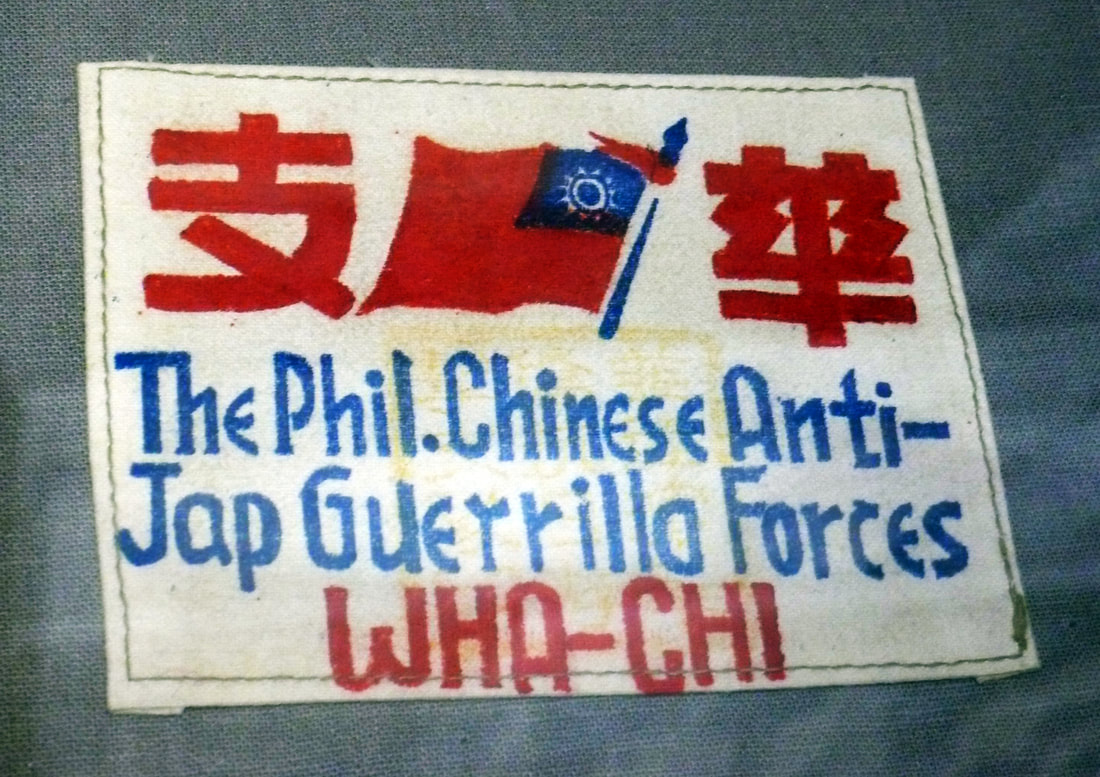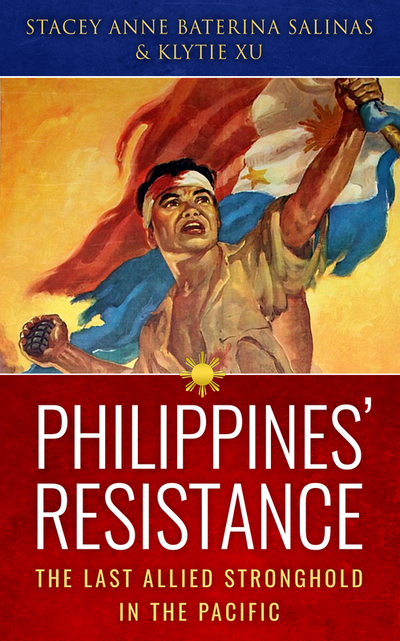- Home
- Stories
-
Internship
- Summer 2024 Internship
- Summer 2023 Internship
- Fall 2022 Internship
- Summer 2022 Internship
- Summer 2021 Internship
- Fall 2020- Spring 2021 Internship
- Summer 2020 Internship
- Fall 2019 Internship
- Summer 2019 Internship >
- School Year 2018-2019 Internship
- Summer 2018 Internship >
- Fall 2017 Internship
- Summer 2017 Internship >
- Books
- Archives
-
Resource Page
-
Supplementary Research Guides
>
- Unit 731 - Guide >
-
Philippines' Resistance - Guide
>
- Philippines World War II Timeline
- The Japanese Invasion & Conquest of the Philippines
- Bataan Death March
- Formation of Underground Philippines Resistance
- Supplies of the Guerrilla Fighters
- The Hukbalahap
- Hunter's ROTC
- Marking's Guerrillas
- United States Army Forces in the Philippines of Northern Luzon (USAFIP-NL)
- The Aetas
- Chinese and Filipino-Chinese Nationalist Guerrilla Units
- The Female Faces of the Philippine Guerrillas
- Rising Sun Flag - Guide >
- Pinay Guerrilleras - Guide >
- Fall of Singapore - Guide >
- Three Years and Eight Months - Guide >
- Siamese Sovereignty - Guide >
- The Khabarovsk War Crimes Trial - Guide >
- Unit 731 Cover-up : The Operation Paperclip of the East - Guide >
- Marutas of Unit 731 - Guide >
- Prince Konoe Memoir - Guide >
- Competing Empires in Burma - Guide >
- Battle of Shanghai - Guide >
- Ishi Shiro - Guide >
- Taiwan The Israel of the East - Guide >
- Seeking Justice for Biological Warfare Victims of Unit 731 - Guide >
- Rice and Revolution - Guide >
- Clash of Empires - Guide >
-
Hunger for Power and Self-SufficiencyI - Guide
>
- The Influence of War Rations on Post-War Culinary Transformations
- How World War II Complicated Food Scarcity and Invention
- American Military Innovations
- Government-Sponsored Food Inventions in Europe during World War II
- Feeding the Army: The Adaptation of Japanese Military Cuisine and Its Impact on the Philippines
- Mixed Dishes: Culinary Innovations Driven by Necessity and Food Scarcity
-
Denial A Quick Look of History of Comfort Women and Present Days’ Complication - Guide
>
- The Comfort Women System and the Fight for Recognition
- The Role of Activism and International Pressure
- The Controversy over Japanese History Textbooks
- The Sonyŏsang Statue and the Symbolism of Public Memorials
- Activism and Support from Japanese Citizens
- The Future of Comfort Women Memorials and Education
- Echoes of Empire: The Power of Japanese Propaganda - Guide >
- Lesson Plans >
-
Supplementary Research Guides
>
Chinese and Filipino-Chinese Nationalist Guerrilla Units (Wa Chi Guerrillas)
Chinese ethnic guerrillas could be found throughout the lowland provinces near Manila on the island of Luzon throughout the war. These guerrilla units were known as the Ampaw Unit led by Colonel Chua Sy Tiao and the 48th Squadron also known as the Wa Chi (other resources spell their unit as Wha Chi) founded May 19th, 1942. Colonel Chua Sy Tiao led the Ampaw which were initially an intelligence guerrilla subunit of Marking’s guerrillas. Their name, Ampaw, translates to the street food snack “puff rice” and became the nickname of the unit because of their undercover spy network in Manila disguised as puff rice street vendors. The Ampaw was founded in Antipolo, Rizal (the Sierra Madre Mountain region) and made up particularly of mestizo Filipinos who had Chinese ancestry who were nicknamed Chilipinos.
Discriminations
Chinese immigrants faced more severe cases of discrimination and interrogation from Japanese soldiers who believed that Chinese immigrants were more prone to joining guerrilla and resistance movements in the Philippines due to the Japanese occupation of mainland China. Colonel Chua, like many of the Chinese guerrillas he organized, was part of the Chinese Nationalist Army and party (Kuomintang) and fought for the liberation of the Philippines so as to prevent the atrocities in China from occurring elsewhere. Chinese soldiers were forewarned about the impending Japanese pan-Asian invasion of the Pacific and were sent, or volunteered, to prevent the atrocities, like the 1937-1938 Rape of Nanking, from occurring elsewhere in the Pacific.
Example of a Chinese-Filipino Guerrilla Soldier
Other Chinese immigrants who would make up the various Chinese Filipino guerrilla units were young men who sought to better their lives and those of their families by working abroad in the Philippines like the Chinese guerrilla, Dee Hong Ki, of the Wa Chi unit. At the age of 13, Dee Hong Ki immigrated to the Philippines in 1936 for better economic opportunities leaving civil war ridden China to make a mark in a small business in the Philippines. A year after Dee Hong Ki’s migration to the Philippine Islands, his hometown Peiping would be invaded. China’s occupation by the Japanese Imperial Army proved to be a warning to Western interests in the Pacific to be on guard of their long held Asian territories (Burma, Vietnam/Indochine, Malays, Philippines, etc). Chinese immigrants, like Dee Hong Ki, in response to the increasing presence of Imperialist Japan would send money to their homelands to help fuel the anti-Japanese resistance on Chinese soil prior to the Filipino American surrender of Corregidor. Chinese immigrants like Dee Hong Ki who had established the Philippines as their home joined the guerrilla underground resistance movement both to avenge their their native country but also to protect and liberate their new homeland. Dee Hong Ki and his brother joined the Wa Chi and as guerrillas, took on a number of missions involving staving off Japanese patrol units in the agrarian fields southeast of Manila (Santa Cruz & San Pablo), and defended villagers and farmers from the Japanese forces.
Strategic Placements of the Wa Chi Guerrillas
Chinese guerrillas had to be extra careful and strategically placed in order to avoid being mistaken as Japanese soldiers and shot at by friendly fire. During the meetings between the guerrilla and USAFFE leaders in regards to the raids, it was decided that the Chinese guerrilla units would have to be kept out of fights with the Japanese in order to avoid any confusion for being mistaken as Japanese themselves in the chaos of the battlefields. The Filipino-Chinese 48th Squadron thus served as guards along the paths and highways that the various guerrilla units would use throughout the duration of the raids from 1944-1945. By collaborating with the Hunters ROTC, Marking’s Guerrillas, and the Huks, as early as 1943, the success of the smaller Chinese-Filipino guerrilla units are a significant representation of the ethnic and political inclusivity, and diversity, that made up the Philippine underground resistance.
Related Book
|
Philippines' Resistance:
The Last Allied Stronghold in the Pacific The people of the Philippine Islands during the early half of the 20th century experienced various waves of Western imperialism, two wars of attempted secession from Western powers, and two world wars. And yet the Philippine Islands and its people have received only small subheadings in many American textbooks and histories.
The wartime experiences from the perspectives of the Philippine people have gone unnoticed and have become overshadowed by the sociopolitical dominating legacy of American figures like General MacArthur, leader and historical symbol of the Pacific Theater during World War II. MacArthur's famous phrase "I came through and shall return" is etched into every facet of World War II historical narratives, textbooks, and monuments that pay tribute to the Allied forces in the retaking of the Pacific from the Japanese. But It is the lesser known people and leaders of the Philippine resistance against the Axis powers whose efforts and contributions allowed for the effective and speedy return of MacArthur's military forces. The Philippine guerrilla resistance consisted of a diverse cast of Filipino men and women, ethnic and indigenous minorities, American and European immigrants and soldiers, young and old, rich and poor, from farmer to politician. The various units of Philippine guerrillas, their tactics, military resources, and vigor to survive and end the Japanese maltreatment of the Philippine peoples paint the Pacific Theater from 1941-1945 as desperate, dark, and bloody for Asian communities throughout East and Southeast Asia. But their resourcefulness, cooperative efforts to collaborate and network with MacArthur across the South Pacific, and massive grassroots liberation movement directly point to the remarkable value that the Philippine Underground Resistance proved to be in aiding the Allies' ability to retake the Pacific |
|
Pacific Atrocities Education
730 Commercial Street San Francisco, CA 94108 415-988-9889 |
Copyright © 2021 Pacific Atrocities Education.
We are a registered 501 (c)(3) charity. |
- Home
- Stories
-
Internship
- Summer 2024 Internship
- Summer 2023 Internship
- Fall 2022 Internship
- Summer 2022 Internship
- Summer 2021 Internship
- Fall 2020- Spring 2021 Internship
- Summer 2020 Internship
- Fall 2019 Internship
- Summer 2019 Internship >
- School Year 2018-2019 Internship
- Summer 2018 Internship >
- Fall 2017 Internship
- Summer 2017 Internship >
- Books
- Archives
-
Resource Page
-
Supplementary Research Guides
>
- Unit 731 - Guide >
-
Philippines' Resistance - Guide
>
- Philippines World War II Timeline
- The Japanese Invasion & Conquest of the Philippines
- Bataan Death March
- Formation of Underground Philippines Resistance
- Supplies of the Guerrilla Fighters
- The Hukbalahap
- Hunter's ROTC
- Marking's Guerrillas
- United States Army Forces in the Philippines of Northern Luzon (USAFIP-NL)
- The Aetas
- Chinese and Filipino-Chinese Nationalist Guerrilla Units
- The Female Faces of the Philippine Guerrillas
- Rising Sun Flag - Guide >
- Pinay Guerrilleras - Guide >
- Fall of Singapore - Guide >
- Three Years and Eight Months - Guide >
- Siamese Sovereignty - Guide >
- The Khabarovsk War Crimes Trial - Guide >
- Unit 731 Cover-up : The Operation Paperclip of the East - Guide >
- Marutas of Unit 731 - Guide >
- Prince Konoe Memoir - Guide >
- Competing Empires in Burma - Guide >
- Battle of Shanghai - Guide >
- Ishi Shiro - Guide >
- Taiwan The Israel of the East - Guide >
- Seeking Justice for Biological Warfare Victims of Unit 731 - Guide >
- Rice and Revolution - Guide >
- Clash of Empires - Guide >
-
Hunger for Power and Self-SufficiencyI - Guide
>
- The Influence of War Rations on Post-War Culinary Transformations
- How World War II Complicated Food Scarcity and Invention
- American Military Innovations
- Government-Sponsored Food Inventions in Europe during World War II
- Feeding the Army: The Adaptation of Japanese Military Cuisine and Its Impact on the Philippines
- Mixed Dishes: Culinary Innovations Driven by Necessity and Food Scarcity
-
Denial A Quick Look of History of Comfort Women and Present Days’ Complication - Guide
>
- The Comfort Women System and the Fight for Recognition
- The Role of Activism and International Pressure
- The Controversy over Japanese History Textbooks
- The Sonyŏsang Statue and the Symbolism of Public Memorials
- Activism and Support from Japanese Citizens
- The Future of Comfort Women Memorials and Education
- Echoes of Empire: The Power of Japanese Propaganda - Guide >
- Lesson Plans >
-
Supplementary Research Guides
>

